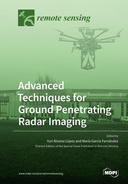Explore

Advanced Techniques for Ground Penetrating Radar Imaging
0 Ungluers have
Faved this Work
Login to Fave
Ground penetrating radar (GPR) has become one of the key technologies in subsurface sensing and, in general, in non-destructive testing (NDT), since it is able to detect both metallic and nonmetallic targets. GPR for NDT has been successfully introduced in a wide range of sectors, such as mining and geology, glaciology, civil engineering and civil works, archaeology, and security and defense. In recent decades, improvements in georeferencing and positioning systems have enabled the introduction of synthetic aperture radar (SAR) techniques in GPR systems, yielding GPR–SAR systems capable of providing high-resolution microwave images. In parallel, the radiofrequency front-end of GPR systems has been optimized in terms of compactness (e.g., smaller Tx/Rx antennas) and cost. These advances, combined with improvements in autonomous platforms, such as unmanned terrestrial and aerial vehicles, have fostered new fields of application for GPR, where fast and reliable detection capabilities are demanded. In addition, processing techniques have been improved, taking advantage of the research conducted in related fields like inverse scattering and imaging. As a result, novel and robust algorithms have been developed for clutter reduction, automatic target recognition, and efficient processing of large sets of measurements to enable real-time imaging, among others. This Special Issue provides an overview of the state of the art in GPR imaging, focusing on the latest advances from both hardware and software perspectives.
This book is included in DOAB.
Why read this book? Have your say.
You must be logged in to comment.
Rights Information
Are you the author or publisher of this work? If so, you can claim it as yours by registering as an Unglue.it rights holder.Downloads
This work has been downloaded 97 times via unglue.it ebook links.
- 97 - pdf (CC BY) at Unglue.it.
Keywords
- applied geophysics
- archaeological prospection
- attribute analysis
- clutter noise removal
- coherence
- coherency functionals
- deep convolutional denoising autoencoders (CDAEs)
- deep convolutional denoising autoencoders with network structure optimization (CDAEsNSO)
- Digital signal processing
- enhancement of 3D-GPR datasets
- Gaussian spike impulse noise
- GPR
- GPR data migration
- GPR data processing
- GPR trace
- ground penetrating radar
- ground penetrating radar (GPR)
- ground-penetrating radar
- high-resolution data
- imaging
- imaging radar
- Improvised Explosive Device
- landmine
- landmine and IED detection
- large-scale survey
- Machine learning
- MIMO radar
- modeling
- n/a
- neural networks
- noise attenuation
- non-destructive testing
- Nondestructive testing
- pipeline identification
- pipelines detection
- Radar
- radar image enhancing
- Real Time Kinematic (RTK)
- semblance
- Signal processing
- Snow
- snow water equivalent (SWE)
- snowpack multilayer reflectance
- software defined radio (SDR)
- spatial-variant convolution kernel (SV-CK)
- spatial-variant convolution neural network (SV-CNN)
- spectral filtering
- stepped-frequency continuous wave radar (SFCW)
- support vector machine
- synthetic aperture radar
- Synthetic Aperture Radar (SAR)
- Technology, engineering, agriculture
- Technology: general issues
- Ultra-Wide-Band (UWB)
- unmanned aerial vehicles (UAVs)
- velocity analysis
- wavelet scattering network
Links
DOI: 10.3390/books978-3-0365-2150-3Editions

